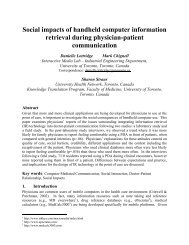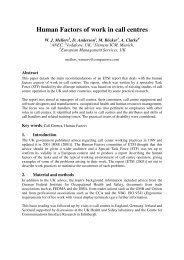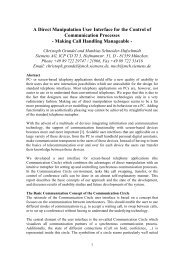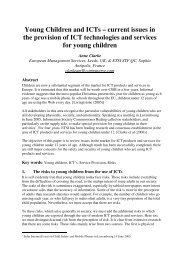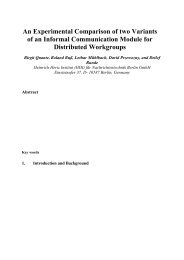Evaluation of a multimodal Virtual Personal Assistant
Evaluation of a multimodal Virtual Personal Assistant
Evaluation of a multimodal Virtual Personal Assistant
You also want an ePaper? Increase the reach of your titles
YUMPU automatically turns print PDFs into web optimized ePapers that Google loves.
forward e-mails to multiple recipients, including a written or recorded message and prioritylevel. They could also ask for an e-mail summary.The dialog strategy followed a mixed-initiative approach and barge-in was supported. Theprompts and hints tried guiding the interaction in the desired direction, providing the mostcommon options and using examples in error situations.USUSUSUSSUSearch for new e-mails from António Silva.You have 2 messages from António Silva.E-mail 1: from António Silva, subject: documentation; received …(barge-in) NextE-mail 2: from António Silva with high priority, subject: meeting tomorrow,received …(barge-in) play me the e-mailThe message says: Please confirm …I want respond to this message.Reply. Say no if wrong.(message recording)Do you want to send the e-mail? You can also add recipients, replay themessage, …(barge-in) Send e-mail with copy to Maria Costa … and blind copy to JoãoAntunes.Figure 2: An example <strong>of</strong> dialog (translated from Portuguese)3. MethodThe evaluation design as well as the protocol and the support materials were developed bythe Royal National Institute <strong>of</strong> the Blind (RNIB) who co-ordinated the user evaluations.For the Portuguese evaluation, we translate and adapt the original material.The evaluation was carried out in a laboratory environment, with 12 native Portuguesespeakers interacting with VPA to carry out a set <strong>of</strong> typical e-mail tasks. The participantsreceived a document with the introductory instructions, the tasks to accomplish and thequestionnaires. At the start <strong>of</strong> the experiment, subjects were given a short explanation <strong>of</strong>the VPA system and the test objective. They fill in a pre-questionnaire with personalinformation and they were asked to sign a consent form to record the experiment. Twoevaluators observed the participants to assist them and to note the issues found and theuser’s comments. After each task, users were required to express their opinion through a 5-point Likert scale questionnaire. A post-test questionnaire was designed also to find out theuser’s overall impression about the system. The questionnaire had a nine 5-point Likertscale statements and a few open questions, to provide feedback on the good and badaspects <strong>of</strong> VPA and their experience. It was also asked about the future use <strong>of</strong> VPA.3.1 ParticipantsA total <strong>of</strong> 12 native speakers without accent were selected from PTIN staff to perform thetests; 8 were males and 4 females, aged from 19 to 46 (mean 30,6 years, std dev 6,4). About75% <strong>of</strong> the participants had an academic education, 16,7 % mid-level education and basicleveleducation the remaining. Three <strong>of</strong> them had experience with spoken-driven applicationsand 2 had little experience. The others don’t have experience with this kind <strong>of</strong> services. None<strong>of</strong> the participants was familiar with the system. The participants were representative <strong>of</strong> the
target VPA users since all them were pr<strong>of</strong>essionals from the ICT domain, with a high mobilitylevel and they were experienced computer and e-mail users.3.2 Experimental setupA mailbox was set up specifically for the evaluations and it was populated with e-mailsrelated with the tasks to carry out. A set <strong>of</strong> 5 tasks was designed to cover the functionalities <strong>of</strong>the system: login and browsing mailbox, search for and reply to an e-mail; search andforward; administer and manage the recipient list and finding and deleting an e-mail. Thecomplexity increased from task 1 to task 5: from browsing the mailbox till a more complexscenario where the user needs to search for an e-mail by sender and to execute the instructionsfrom that e-mail. The tasks were described as open scenarios to allow the users to take theinitiative and to experiment the system.For the users trials the graphic interface was a web-based page, simulating a mobile phone.The users used a desktop PC with Internet access to interact with the GUI and a fixed phoneto convey voice to the system.Figure 3: The graphical interface“InoVox”, an IVR platform developed by PTIN, recorded the user utterances in full. Inaddiction to the system log files, a tool, developed by VOX, allowed the analysis <strong>of</strong> thespoken interaction between the user and the system.4. ResultsMetrics collected per session consisted <strong>of</strong> objective metrics extracted from the logging andsubjective metrics collected via the questionnaires. In addition, the evaluators annotated byhand all the events that occur during the tasks execution. The questionnaires were used to
obtain the user satisfaction by asking the user to specify the degree to which they agreed withthe set <strong>of</strong> statements on a 5-point Likert scale, from ‘Very satisfied’ to ‘Very unsatisfied’.Even if too few users participated to allow for statistical manipulation <strong>of</strong> results, we think thatthere are interesting findings, which could be confirmed in subsequent larger scale studies.4.1 Task analysisFor each task, several objective measures were taken during experiments. The evaluatorsannotated the time elapsed to complete the task, the actual task completion and the number <strong>of</strong>Graphical User Interfaces (GUI) interactions. From the logs <strong>of</strong> the spoken interaction we alsocollected the concept accuracy (correct answers to users request), the user utterances withoutresponse, the number <strong>of</strong> misunderstandings and the incorrect answers from the system.The Table 1 present the values collected by task: the time in minutes to complete the task(median and range), the task completion rate, the number <strong>of</strong> spoken and graphical interactions(median and range) and the system performance values (in percentage).Task Time(range)T1 10(7-18)T2 7(5-12)T3 5(3-16)T4 6(2-10)T5 10(4-18)Table 1: Task summaryInteractions Spoken interaction (%)Comp. VUI GUI. Correct No Misunderst Incorrect%responses Responses andings responses83,3 14,0 6,5 54,3 13,7 6,8 25,2(9-49) (0-22)75 11,5 4,5 60,2 11,4 8,5 19,9(5-33) (0-16)100 14,5 1,5 67 9,8 9,8 13,3(1-26) (0-20)50 16;5 2 55,84 7,4 18,6 18,2(4-41) (0-6)75 32 4 59,4 9,4 9,4 21,8(9-66) (0-11)Task one was an exploratory task to allow the user to become familiarized with the systemand with the different interaction modes. In the remaining tasks, the user goal was toaccomplish the task objective. The majority <strong>of</strong> the incomplete tasks were result <strong>of</strong> systemstability problems.4.2 Questionnaire Overall ResultsThe post-test questionnaire had a nine 5-point Likert scale statements and a few openquestions, to provide feedback on the good and bad aspects <strong>of</strong> VPA and their experience. Itwas also asked about the future use <strong>of</strong> VPA.The users were asked to express their opinion from “very satisfied” to “very unsatisfied” witha neutral point. The questionnaire questions asked for:• how intuitive was the interface,• how easy was work with the system,• how confident users were using the system,• how satisfied they were in general with the system and the experience,• how satisfied they were with the interaction control (where they were and what to do),
• how satisfied were with the interaction quality, particularly with the recognition errors,• how appreciate the TTS voice for prompts,• how appreciate the TTS voice for e-mail reading,• how satisfied were with the dialog with the system.Overall resultsDialogTTSEmailsTTSPromptsErroRecogWhere&AboutSatisfactionConfidenceEasyIntuitiveness0 1 2 3 4 5min -[ lower quartile - median - upper quartile ]- maxFigure 4: Post-test questionnaire: median and inter-quartile range.The results <strong>of</strong> the overall appreciation (for the individual components <strong>of</strong> the post-testquestionnaire) are shown in the box plot in Figure 4. The central box represents the distancebetween the first and third quartiles with the median between them marked with a diamond;the minimum and the maximum values are marked in the lines extremes (1 stands for “verysatisfied” and 5 for “very unsatisfied”). The VPA was seen as easy to use and intuitive (onlyone user used the system Help). The interaction control (where&about) was appreciated too.The overall satisfaction had a neutral appreciation (median=3; mode=4). The questionregarding the interaction quality (related with error recognition) was severely ranked by theusers: median= 4 (unsatisfied). The quality <strong>of</strong> dialog and the confidence had a neutralappreciation, as well as the TTS quality.The study <strong>of</strong> the relationships between the overall satisfaction and the remaining statementsusing Spearman’s correlation coefficient indicate a significant correlation with easy <strong>of</strong> use(=0,74); confidence (=0,79), dialog (=0,87); interaction control (=0,73) and errorrecognition (=0,69). The values for intuitiveness and the TTS quality <strong>of</strong> prompts and e-mailsreading were not significant.The results <strong>of</strong> Mann-Whitney test did not show evidence for differences between females andmales. Regarding the experimented or naïve users, the Kruskal-Wallis test results lack <strong>of</strong>statistical significance too.
To find the relationship between user overall satisfaction (subjective) and the conceptaccuracy (objective) we calculate the correlation between them. Not surprising, the result <strong>of</strong>Spearman correlation was statistically significative: =0,85, p=0,0004. However, no statisticalrelationship was found between the concept accuracy values and the interaction quality, thesubjective evaluation <strong>of</strong> error recognition.5. DiscussionTable 1 show that the preferred modality was speech. The users followed a similar approachto interact with the system: they used speech input to convey the commands and use thegraphical interface to read the messages and to scroll quickly through the contacts list. A moreintensive use <strong>of</strong> the GUI occurred when the system presented problems, in order to overcomethe recognition or understanding errors and the slowness <strong>of</strong> the system response.The users tried to use natural language, using short phrases but with complex commands.Only one user adopted a very pragmatic style since the beginning and for all the tasks: shortcommand utterances and GUI confirmations/commands to speed up task completion. Incontrast, another user used a real natural language approach, with out-<strong>of</strong>-context utterances,hesitations and so on. As a curiosity, the overall concept accuracy for the first user was 71,4%and for the second was 52,4%.The majority <strong>of</strong> the users used and appreciated a mixed initiative dialogue. However, thesystem initiative several times annoyed the users because it was most <strong>of</strong>ten inappropriate orout <strong>of</strong> context. For instance, the system prompt warning the user that he was trying to send amessage without recipients was welcomed; but, when the user compose the message with therecipients and said “send” and the system answer is “ who would you like to send it to?”, theuser feel frustration. Besides the system stability problems one possible explanation is theover-confirmation strategy implemented.From the post-test questionnaire results, we can conclude that the overall user satisfaction isinfluenced by the easy <strong>of</strong> use <strong>of</strong> the system, the control that the user had upon the systemactions and the quality <strong>of</strong> the interaction. The use <strong>of</strong> the TTS Portuguese voice was wellaccepted by the users.The lack <strong>of</strong> correlation between the concept accuracy (objective values) and the interactionquality (subjective evaluation <strong>of</strong> error recognition), suggest that the user perception <strong>of</strong> therecognition accuracy is influenced by others factors, for instance the system response time.However, this aspect needs a more detailed study.The user opinions ranged from positive to very negative but for the majority <strong>of</strong> the users theoverall opinion was positive. The <strong>multimodal</strong> VPA concept was attractive to all users and wasseen as a key enabler supporting the growing user mobile attitude.When asked about the future use <strong>of</strong> the system 33% <strong>of</strong> the users said that they would use it,one user don’t answer and 58% said that they wouldn’t use the system. The main reasons forsuch negative answers were the system's significant latency (slow response time) and therecognition problems.
6. ConclusionsWe presented the preliminary results concerning the user evaluation <strong>of</strong> a <strong>Virtual</strong> <strong>Assistant</strong>prototype developed in the context <strong>of</strong> the FASiL project.The conversational and <strong>multimodal</strong> approach to this kind <strong>of</strong> applications was very wellaccepted and supported by the users.We can conclude that the quality and speed <strong>of</strong> the system feedback as well as the recognitionaccuracy <strong>of</strong> the spoken components are key factors to a better user experience and for theacceptance and use <strong>of</strong> voice-enabled systems. The GUI approach adopted as a mean toovercome the slowness <strong>of</strong> the system response and the recognition problems suggest that<strong>multimodal</strong> interfaces can overcome the weaknesses <strong>of</strong> each modality and exploit the fullstrengths <strong>of</strong> combined modes.However, improvements are needed to increase the recognition accuracy <strong>of</strong> the spokencomponents, providing a better user experience and open the door to the acceptance anddivulgation <strong>of</strong> <strong>multimodal</strong> systems.7. AcknowledgementsWe would like to thank all the participants, who kindly participated in the User trial. Wewould like to thank also to all FASiL partners: CapGemini (Sweden), MIT Media Lab Europe(Ireland), ScanS<strong>of</strong>t, Inc (USA), The Royal National Institute for the Blind (UK), The RoyalNational Institute for Deaf People (UK), University <strong>of</strong> Sheffield (UK), Vox Generation Ltd(UK), for their contributions.This research was supported by the EU Grant FASiL IST 2001-38685.References[1] Alexander, T., Dixon, E. Usability <strong>Evaluation</strong> Report for VPA 2 (Public Version).FASiL deliverable D.3.3.3, 2004.[2] Almeida, L., Amdal, I., Beires, N., Boualem, M., Boves, L., den Os, E., Filoche, P.,Gomes, R., Knudsen, J.E., Kvale, K., Rugelbak, J., Tallec, C., Warakagoda, N. Implementingand evaluating a <strong>multimodal</strong> and multilingual tourist guide. Proc. CLASS Workshop onNatural, Intelligent and Effective Interaction in Multimodal Dialogue Systems (2002).[3] Dybkjær, L., Bernsen, N.O., Dybkjær, H. Usability <strong>Evaluation</strong> Issues in Commercialand Research Systems. COST Workshop (2005).[4] Hemsen, H. Designing a <strong>multimodal</strong> dialogue system for mobile phones. Proc. <strong>of</strong> the1st Nordic Symposium on Multimodal Communication (2003).[5] James, F., Rayner, M., Hockey, B.A. Accuracy, Coverage, and Speed: What Do TheyMean to Users? CHI Workshop on Natural Language Interfaces (2000).[6] Oviatt, S, De Angeli, Kuhn, K. Integration and synchronization <strong>of</strong> input modes during<strong>multimodal</strong> human-computer interaction. Proc. CHI 1997.[7] Oviatt, S. Ten myths <strong>of</strong> <strong>multimodal</strong> interaction. Communications <strong>of</strong> the ACM (1999),75-81.[8] Pieraccini, R., Carpenter, B., Woudenberg, E., Caskey, S., Springer, S., Bloom, J.,Phillips, M. Multimodal spoken dialog with wireless devices. Proc. <strong>of</strong> the ISCA Tutorial andResearch Workshop (2002).[9] Pieraccini, R., Huerta, J. M. Where do we go from here? Research and CommercialSpoken Dialog Systems. Proc. <strong>of</strong> 6 th SIGdialWorkshop on Discourse and Dialogue (2005).



